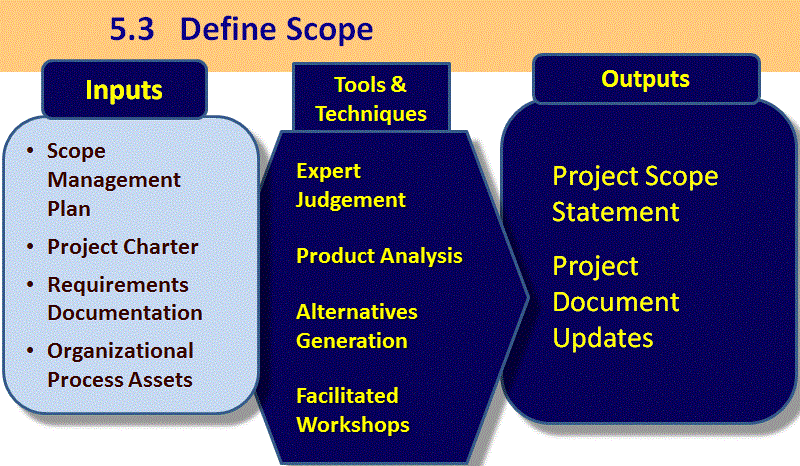Looking for Global training? Go to https://firebrand.training/en or stay on the current site (Sverige)
TERMS AND CONDITIONS
Firebrand Training grants you a personal, non-exclusive, non-transferable license to access and use the site. You may download or print material from the site only for your own personal, non-commercial use. Please read our full terms and conditions.
5.3 Define Scope
"The process of developing a detailed description of the project and product."
The definition shown above in italics is taken from the Glossary of the Project Management Institute, A Guide to the Project Management Body of Knowledge, (PMBOK® Guide) – Fifth Edition, Project Management Institute Inc., 2013

Project Management Institute, A Guide to the Project Management Body of Knowledge, (PMBOK® Guide) – Fifth Edition, Project Management Institute Inc., 2013 Figure 5-7 Page 120
Defining Scope:
- Documents the features and functionality of the product, service, or result.
- Describes the boundaries for the project, service or result – scope and exclusions
- Objective = Agreement by all parties
- Give customer “No more and No less than what was specified”, giving the customer more than they ask for is “Gold Plating”. The PMI does not approve Gold Plating.
- Requirements can evolve over time during the project as understanding is developed (progressive elaboration)
- Poor scope definition can result in cost increases, rework, schedule delays, poor morale
Project Scope – Two aspects
1.Product scope
- Features and Functions
- Product scope completion is measured against the product requirements
- Which are captured as Acceptance Criteria, shown in the:
- Project Charter (high level)
- Requirements Management Plan and Requirements Traceability Matrix
- Project Scope Statement
2.Project scope
- "The work that needs to be accomplished to deliver a product or service, or result, with the specified features and functions."
The definition shown in italics is taken from the Glossary of the Project Management Institute, A Guide to the Project Management Body of Knowledge, (PMBOK® Guide) – Fifth Edition, Project Management Institute Inc., 2013
Product Analysis
- Product breakdown
- System analysis
- Requirements analysis
- Systems engineering
- Looking at the whole system to include environmental factors to the product e.g. other hardware/software which the product must function or interact with
- Value engineering
- Identifying and developing the cost:benefit ratio for each product function
- Value analysis
- Analysing value of all functions to identify those unnecessary which increase costs
Questions:
Is the product complete or are functions missing?
Are some requirements or functions contradictory?
Is the product too complex to produce?
Converts product description and project objectives into tangible deliverables and technical requirements.
Alternatives Generation
Brainstorming – joint creative thinking that first records all possible options/solutions without judgment, then allows for critical evaluation of the options.
Nominal Group Technique - brainstorming with a voting process, to rank the best ideas for further brainstorming or prioritization.
Affinity Diagram - gathering ideas and sorting them into groups for review and analysis –identifying patterns in data.
Mind Mapping - a graphical method of rapidly identifying and relating all issues relevant to a selected topic.
Lateral Thinking - creative out-of-the-box thinking to generate possibilities
Project Objectives:
- Specific (scope)
- Quantifiable (time, cost, quality)
- Aligned with business targets, policies, procedures.
- Objectives should be SMART(ER)
- Specific
- Measureable
- Achieveable
- Realistic
- Timely
- Exciting
- Reviewable
Example:
Implement a wristband based BPIS (barcoded patient identification system) integrated with the HIS in the Coventry & Warwickshire University Hospital Trust, identifying 95% of patients in the inpatient and outpatient HIS applications, within 9 months and a budget of £150,000
Project Scope Statement
Defines the project and contains:
- Product Scope Description
- Acceptance Criteria
- Deliverable(s) (including PM reports/documents)
- Project boundaries and exclusions
- Constraints
- Assumptions
Some of these may be by referring to information in other documents
Question
At the beginning of the project, you hold a meeting with stakeholders to figure out how everyone will communicate as the work goes on. Which of the following terms best describes that meeting?
A. Qualitative Analysis
B. Communication Plan meeting
C. Kick-off meeting
D. Status meeting
Answer
C - The Kick-off meeting gets all of the stakeholders together to explain how communication will go. That way, everyone knows who to talk to if things go wrong or they run into any questions
DISCLAIMER
Firebrand Training grants you a personal, non-exclusive, non-transferable license to access and use the site. You may download or print material from the site only for your own personal, non-commercial use. Read our full terms and conditions on https://firebrand.training/se/learn/terms-and-conditions.
 Part of the BPP Education Group
Part of the BPP Education Group